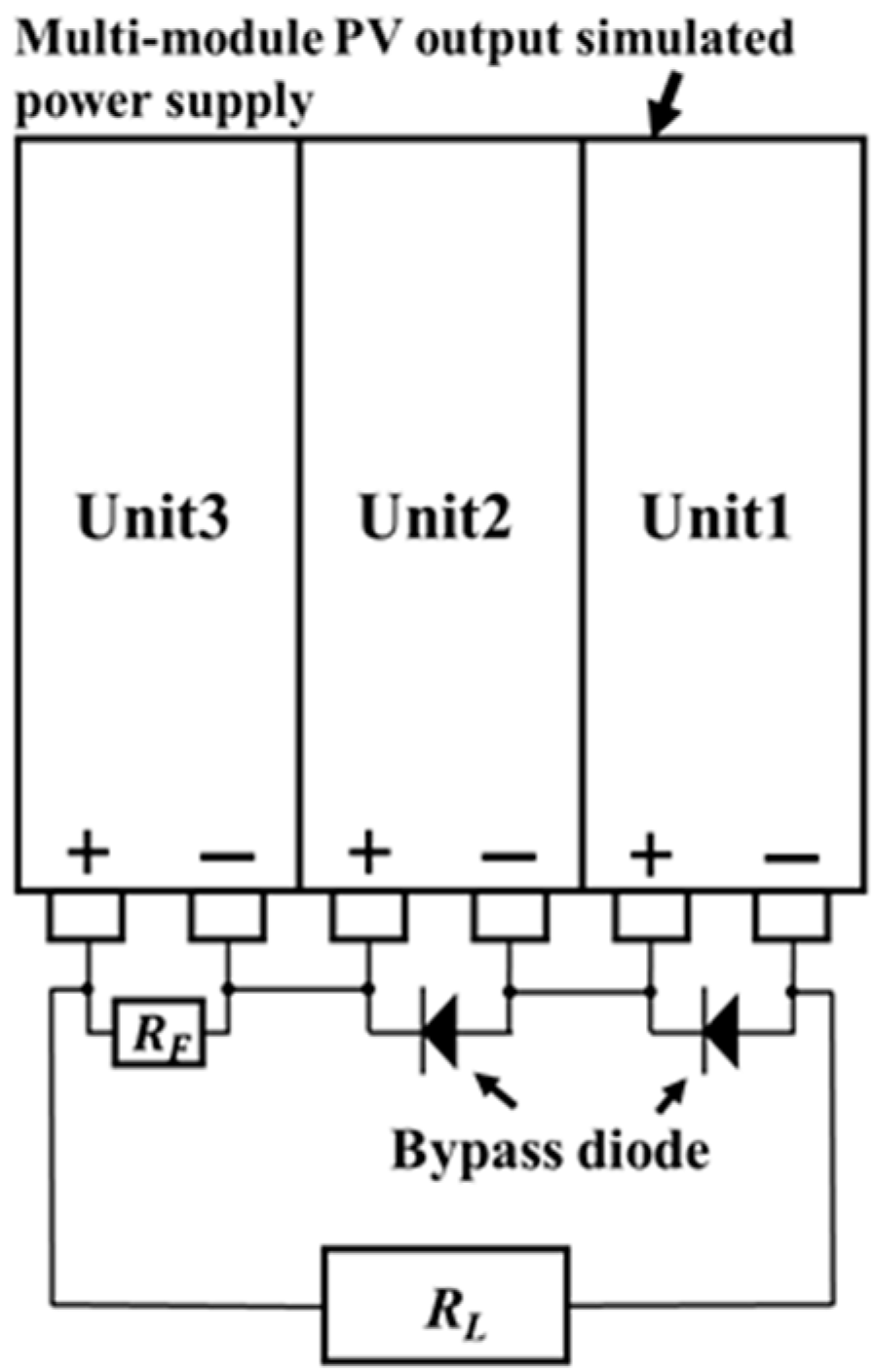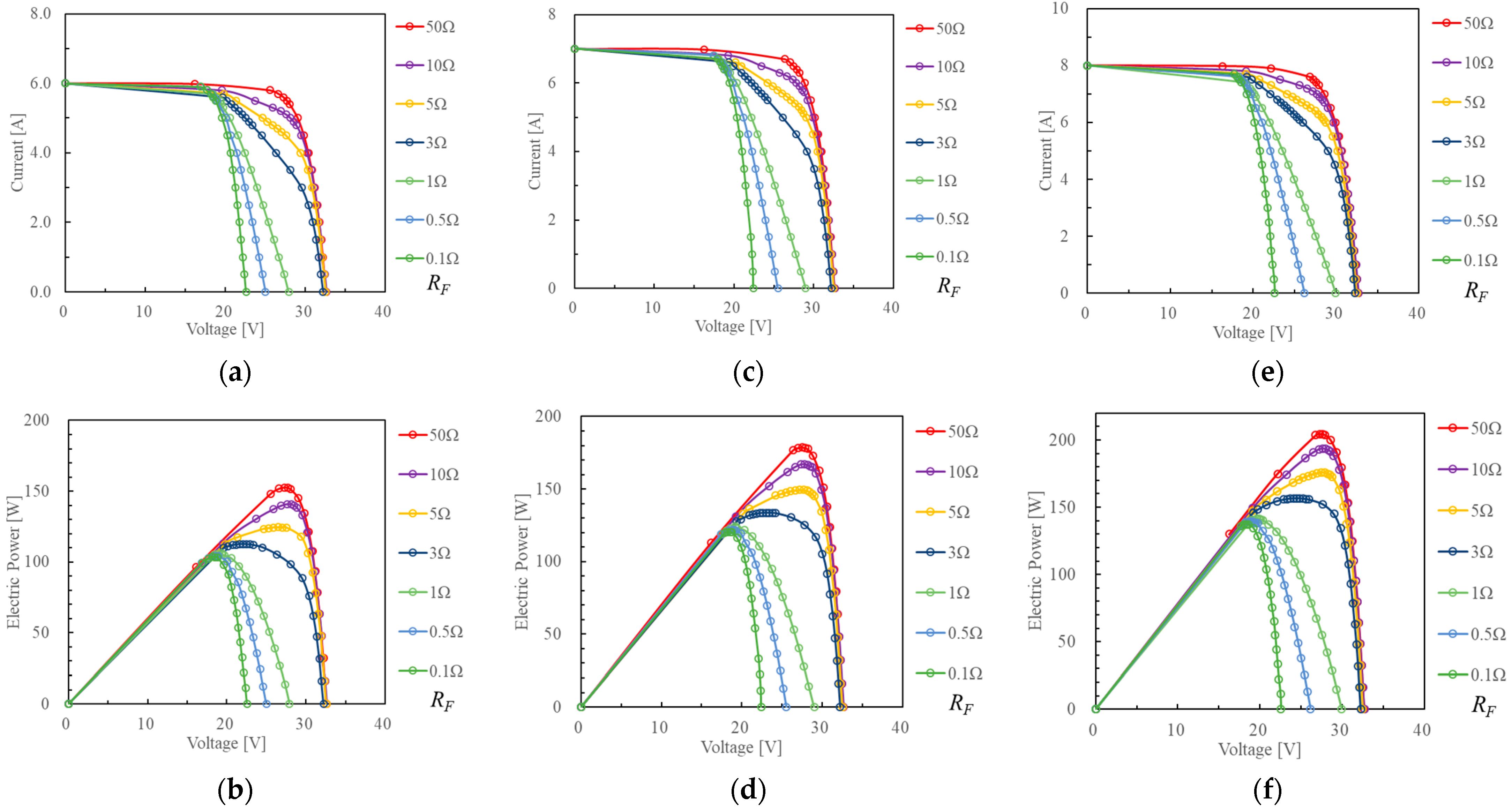Impact of Bypass Diode Fault Resistance Values on Burnout in Bypass Diode Failures in Simulated Photovoltaic Modules with Various Output Parameters
Abstract
:1. Introduction
2. Materials and Methods
3. Results and Discussions
3.1. Verification of Burnout Risk of Faulty BPD in BPD Fault Simulation PV Modules at Short-Circuit Currents
3.2. Verification of Burnout Risk of Faulty BPDs in the BPD Fault Simulation PV Module at Different Open-Circuit Voltages
3.3. Verification of Burnout Risk of Faulty BPD in BPD Fault Simulation PV Module with Different Fill Factors
4. Discussion
5. Conclusions
Author Contributions
Funding
Data Availability Statement
Acknowledgments
Conflicts of Interest
References
- Plan, S.E. Agency for Natural Resources and Energy, Ministry of Economy, Trade and Industry Japan. 2022. Available online: https://www.enecho.meti.go.jp/about/whitepaper/2020pdf/whitepaper2020pdf_3_3.pdf (accessed on 4 August 2023).
- Ministry of Economy, Trade and Industry; Agency for Natural Resources and Energy. Japan‘s Energy 10 Questions for Understanding the Current Energy Situation; Ministry of Economy, Trade and Industry; Agency for Natural Resources and Energy: Tokyo, Japan, 2022. [Google Scholar]
- Köntges, M.; Kurtz, S.; Packard, C.; Jahn, U.; Berger, K.A.; Kato, K.; Friesen, T.; Liu, H.; Van Iseghem, M.; Wohlgemuth, J.; et al. Review of Failures of Photovoltaic Modules; International Energy Agency: Paris, France, 2014; Available online: https://repository.supsi.ch/9645/1/IEA-PVPS_T13-01_2014_Review_of_Failures_of_Photovoltaic_Modules_Final.pdf (accessed on 4 August 2023).
- Oke, S.; Sakai, H.; Tottori, H.; Shimizu, Y.; Nanno, I.; Hamada, T.; Ishikura, N.; Fujii, M. Characteristics and risks of broken bypass diode with induced lightning. In Proceedings of the Grand Renewable Energy, Yokohama, Japan, 17–22 June 2018. [Google Scholar]
- Oke, S.; Sakai, H.; Tottori, H.; Shimizu, Y.; Choo, N.; Nanno, I.; Hamada, T.; Ishikura, N.; Fujii, M. I-V characteristics of broken bypass diode on PV module. In Proceedings of the 35th EU-PVSEC, Brussels, Belgium, 24–28 September 2018; pp. 1996–2000. [Google Scholar]
- Oke, S. Influence of induced lightning on photovoltaic power generation equipment. Annu. Meet. Rec. IEE Jpn. 2019, 6, S6. [Google Scholar]
- Hamada, T.; Nakamoto, K.; Nanno, I.; Ishikura, N.; Fujii, S.O.M. Effect of failure characteristics of bypass diode in photovoltaic solar module on burnout. J. Inst. Elect. Instal. Engnr. Jpn. 2022, 42, 16–17. (In Japanese) [Google Scholar]
- Azuma, T. Study on the Relationship between Power Consumption and Electrical Characteristics of a Failed BPD during Load Operation of a Photovoltaic Module with Bypass Diode Failure. In Proceedings of the Grand Renewable Energy 2022 International Conference (GRE2022), Tokyo, Japan, 13–20 December 2022. [Google Scholar]










Disclaimer/Publisher’s Note: The statements, opinions and data contained in all publications are solely those of the individual author(s) and contributor(s) and not of MDPI and/or the editor(s). MDPI and/or the editor(s) disclaim responsibility for any injury to people or property resulting from any ideas, methods, instructions or products referred to in the content. |
© 2023 by the authors. Licensee MDPI, Basel, Switzerland. This article is an open access article distributed under the terms and conditions of the Creative Commons Attribution (CC BY) license (https://creativecommons.org/licenses/by/4.0/).
Share and Cite
Hamada, T.; Azuma, T.; Nanno, I.; Ishikura, N.; Fujii, M.; Oke, S. Impact of Bypass Diode Fault Resistance Values on Burnout in Bypass Diode Failures in Simulated Photovoltaic Modules with Various Output Parameters. Energies 2023, 16, 5879. https://doi.org/10.3390/en16165879
Hamada T, Azuma T, Nanno I, Ishikura N, Fujii M, Oke S. Impact of Bypass Diode Fault Resistance Values on Burnout in Bypass Diode Failures in Simulated Photovoltaic Modules with Various Output Parameters. Energies. 2023; 16(16):5879. https://doi.org/10.3390/en16165879
Chicago/Turabian StyleHamada, Toshiyuki, Tomoki Azuma, Ikuo Nanno, Norio Ishikura, Masayuki Fujii, and Shinichiro Oke. 2023. "Impact of Bypass Diode Fault Resistance Values on Burnout in Bypass Diode Failures in Simulated Photovoltaic Modules with Various Output Parameters" Energies 16, no. 16: 5879. https://doi.org/10.3390/en16165879
APA StyleHamada, T., Azuma, T., Nanno, I., Ishikura, N., Fujii, M., & Oke, S. (2023). Impact of Bypass Diode Fault Resistance Values on Burnout in Bypass Diode Failures in Simulated Photovoltaic Modules with Various Output Parameters. Energies, 16(16), 5879. https://doi.org/10.3390/en16165879





